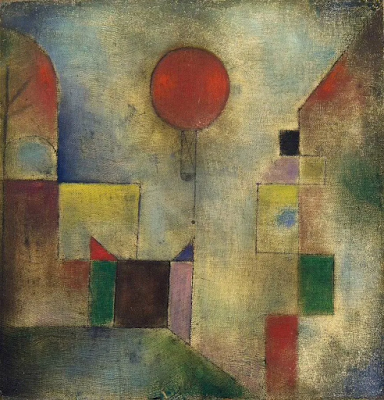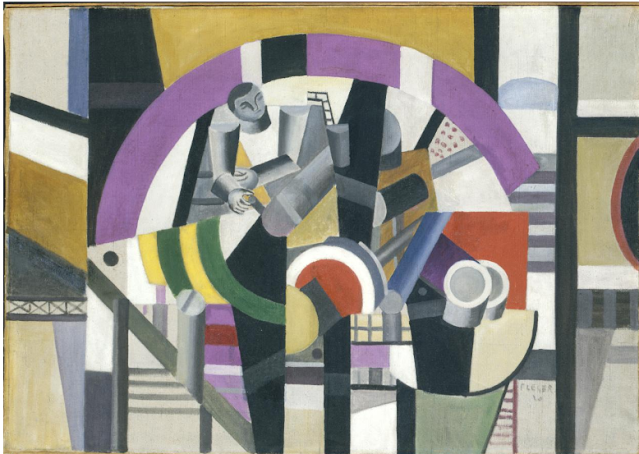Paul Klee, The Red Balloon
This week we look at an artist who has always been a mystery to me, I think mainly because he didn't fit nicely into any of the interesting art movements of the early 20th century. Paul Klee (1879-1940) experimented with all of them until eventually developing a unique and very expressive symbolism which often bordered on the whimsical.
The Red Balloon was painted in 1922 when Klee taught at the Bauhaus, the famous Germany design school. The beautiful structure illustrates the Bauhaus influence. Right down the middle, the thin line cements the balloon and divides the entire format. On the left the large green shape reminds the viewer of ground, while stacked geometric shapes indicate human structures, buildings. Notice how the sky varies in color and value, probably indicating sunshine, daylight.
From here it is up to us to take from this painting what we desire. If we look into Klee's history we discover a very complex man. But now, this painting must stand on it's own merits, as Klee has presented it to the world for personal interpretation.
The Red Balloon is an oil on chalk primed gauze/muslin mounted on board. It measures 13"x 12" and can be found at the Solomon R. Guggenheim Museum, New York City.
Paul Klee was born in Switzerland to a German father, Swiss mother, however he lived his early life in Germany. The Nazi's listed him as a Galician Jew, and when they came to power in January, 1933, the Klee family quickly moved to Switzerland, where they remained. Klee was well accepted during his lifetime as a contemporary avant-garde artist, all except for the Nazi's who destroyed much of his work.
Make Art a part of your life, it's a beautiful thing to do.
The Red Balloon was painted in 1922 when Klee taught at the Bauhaus, the famous Germany design school. The beautiful structure illustrates the Bauhaus influence. Right down the middle, the thin line cements the balloon and divides the entire format. On the left the large green shape reminds the viewer of ground, while stacked geometric shapes indicate human structures, buildings. Notice how the sky varies in color and value, probably indicating sunshine, daylight.
From here it is up to us to take from this painting what we desire. If we look into Klee's history we discover a very complex man. But now, this painting must stand on it's own merits, as Klee has presented it to the world for personal interpretation.
The Red Balloon is an oil on chalk primed gauze/muslin mounted on board. It measures 13"x 12" and can be found at the Solomon R. Guggenheim Museum, New York City.
Paul Klee was born in Switzerland to a German father, Swiss mother, however he lived his early life in Germany. The Nazi's listed him as a Galician Jew, and when they came to power in January, 1933, the Klee family quickly moved to Switzerland, where they remained. Klee was well accepted during his lifetime as a contemporary avant-garde artist, all except for the Nazi's who destroyed much of his work.
Make Art a part of your life, it's a beautiful thing to do.




I like his strong geometric shapes but I am more interested in the spaces which look like they have layered or glazed to fuse the colors. The linen gives it a beautiful texture, and I imagine looking at it closely would also show brush strokes. He mixes all the primary colors, and even with the soft tones it has a bit of an industrial look to me. The composition invites imagination. I think the black squares are quite important.
ReplyDelete